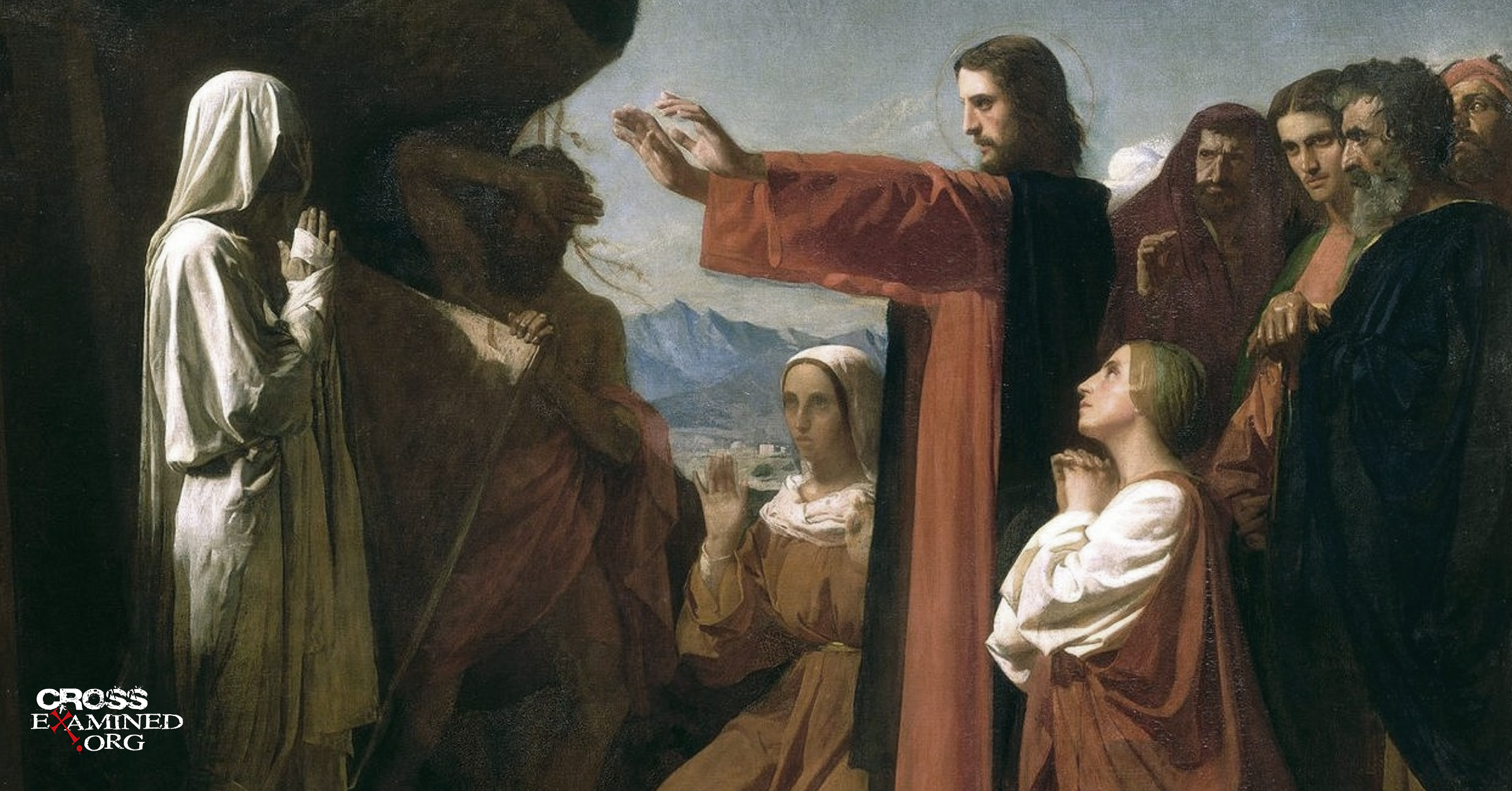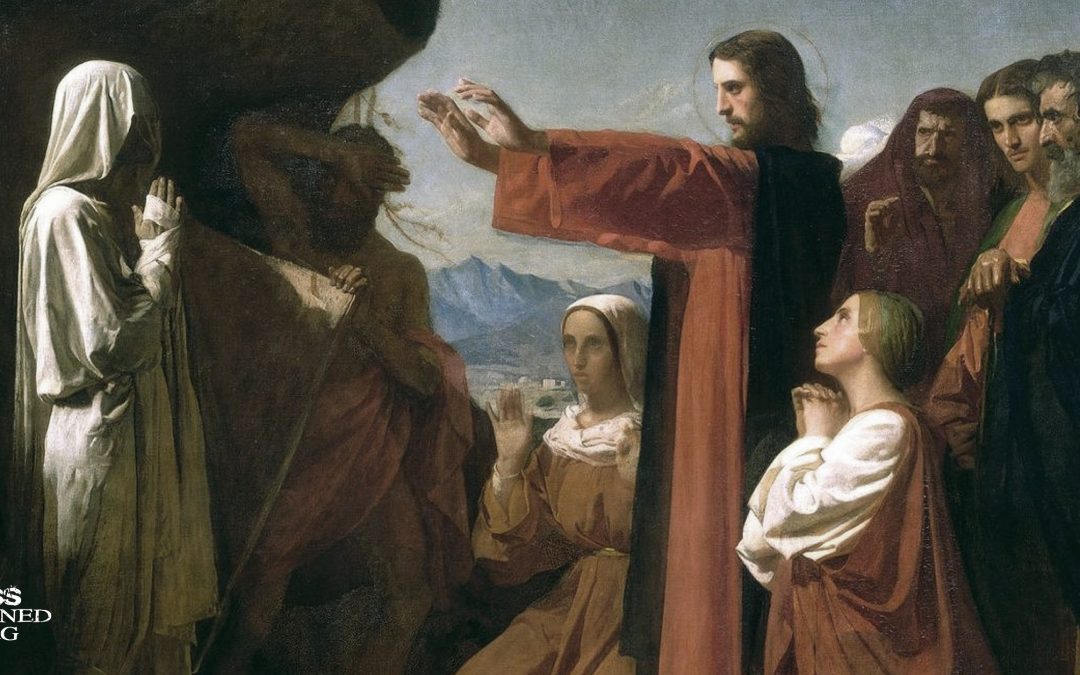Jesus raising Lazarus from the dead is one of the most well-known stories in the Gospels. Yet, for some reason, Matthew, Mark, and Luke don’t mention it. This head-scratching absence has raised a lot of doubts about its historicity. After all, this story seems too significant to leave out. As you can imagine, skeptics think John made it up. But could there be a good reason that the earlier Gospels left it out?

While it does seem strange that the synoptic writers would leave out this story, I believe we have a good explanation for its absence in what Gerd Theissen calls “protective anonymity.”[1]
Pre-Markan Tradition
Protective anonymity is based on the premise that a pre-Markan tradition stands behind the passion narrative in Mark 14-16. In other words, while Mark composed much of his Gospel based on Peter’s eyewitness testimony, the last few chapters came from another source that dates much closer to the time of Jesus’ death and resurrection. While biblical scholars are somewhat divided on this issue, the evidence tilts in favor of this pre-Markan source.
For example, scholars have long noted that Mark didn’t arrange the pericopes (e.g., miracles, parables, proclamations, narratives, exorcisms, etc.) chronologically. Rather, he ordered them in ways that suited his purposes. In fact, Matthew and Luke’s orders often diverge from Mark’s. Meaning, Mark could have easily rearranged the stories in a different order without impacting the overall message. However, when one gets to the passion narrative, the entire account presupposes a chronological order. Instead of one short story after another, the entire passion account (ch. 14-16, possibly ch. 11-16) flows like one continuous narrative. Certainly, Mark could have composed these last few chapters himself. But a few features from the text suggest that it was composed earlier and in Jerusalem.
One reason for adopting this view is that Mark mentions “the high priest” but never mentions him by name (Caiaphas). This phrasing would be akin to saying “the president” instead of President Biden. If I had a conversation with someone today and mentioned “the president,” no one would think I was talking about Trump, Obama, Bush, or any other previous president. They would assume I was talking about our current president. The same could be said for Caiaphas. Since he ruled till AD 37, the passion narrative that merely refers to him as “the high priest” must have been in circulation before his tenure ended.
Another reason for thinking that the passion account is early and from Jerusalem is the mention of “James the younger” in Mark 15:40. Theissen argues, “It would have been particularly necessary in Jerusalem to distinguish a ‘James the younger’ (or ‘the less’) from the ‘older’ (or ‘greater’).”[2] He suggests that “James the younger” was the brother of Jesus, and “James the older” was the Son of Zebedee. If Theissen is right, then the need to distinguish the two James would have been necessary in Jerusalem where “James the younger” was overseer of the church. Furthermore, the need to distinguish the two James would only be necessary until AD 44 when “James the older” died.
One more reason for thinking the passion narrative is a pre-Markan tradition is the mention of “the insurrection” in which Barabbas was involved (Mark 15:7). Jews, however, were familiar with a significant uprising led by Theudas in AD 44-45 (Acts 5:36).[3] One would think that if Mark wrote this passion account in the 50s or 60s, he would have been careful to distinguish which uprising Barabbas participated in. The mere mention of “the insurrection” suggests that this narrative pre-dates the insurrection led by Theudas in AD 44-45.
Protective Anonymity
With the pre-Markan tradition established, we are now in a position to answer the question of why Lazarus is never mentioned. Theissen argues that people are left anonymous or unmentioned because if their names got back to the Jerusalem authorities, they could be implicated as accomplices in Jesus’ “revolt.”
Consider the person who cut off the ear of the high priest’s servant in Mark 14:47. Mark never mentions him by name. He simply notes that “one of those who stood by drew his sword and struck the servant of the high priest and cut off his ear.” Mark doesn’t even make it clear if this is one of Jesus’ disciples. It’s not until John’s Gospel—written around AD 90—that we discover that the identity of this sword-wielding character is none other than Peter himself. John no longer feels the need to protect Peter’s identity because he was long dead by now. Since Peter most likely would have faced arrest for this attempted murder on the high priest’s servant, this early pre-Markan tradition kept him anonymous.
Another case of protective anonymity is the woman who anointed Jesus in Mark 14:3-9. Her actions would undoubtedly make her an accomplice in Jesus’ messianic “revolt.” Bauckham remarks,
At the time when this tradition took shape in this form in the early Jerusalem church, this woman would have been in danger were she identified as having been complicit in Jesus’ political subversive claim to messianic kingship. Her danger was perhaps even greater than that of the man who attacked the servant of the high priest, for it was she who had anointed Jesus as Messiah.[4]
It’s worth noting that Judas immediately betrayed Jesus to the authorities following the anointing. Once again, it’s John who reveals the identity of this woman as Mary, the sister of Martha and Lazarus, when she no longer needed protective anonymity.
Lazarus
If we are right to believe that the pre-Markan passion narrative intentionally kept people anonymous for their protection, we could understand how it would leave Lazarus out of the story altogether. After all, John 12:10-11 notes that “the chief priests made plans to put Lazarus to death as well, because on account of him many of the Jews were going away and believing in Jesus.” That is to say, Lazarus was a thorn in the side of the Jewish leaders because he was convincing Jews to become Christians by simply walking around. Because Jewish leaders continued to persecute the early church for decades, this early passion narrative had to leave him out of the story altogether for his own protection.
However, some have argued that perhaps Lazarus does sneak into Mark’s passion narrative after all. During Jesus’ arrest, we read, “And a young man followed him, with nothing but a linen cloth about his body. And they seized him, but he left the linen cloth and ran away naked” (Mark 14:51-52). Without sounding too immature, I laugh every time I read about this anonymous streaker. Yet, this account is more significant than it may appear. With all the commotion going on (Peter had just whacked off someone’s ear), none of the disciples probably observed this scene. They had already “left him and fled” (Mark 14:50). Therefore, this story must go back to the eyewitness testimony of the streaker himself.
Again, his anonymity was necessary for his protection. After all, the only reason he must have fled naked is because he resisted the guards. Once they grabbed him, he was able to slip away, leaving his linen cloth behind. Undoubtedly, the Jewish leaders would have been looking to arrest this man who fought against them.
So who was this man? Some have argued that it was Lazarus. Wanting to still acknowledge Lazarus’ importance, this early account allows him this brief and very comical appearance. Others have argued that this person is John Mark himself. Like Alfred Hitchcock appearing in one of his own films or an artist painting himself into his picture, Mark inserted himself into the narrative. I don’t think we can know for sure. Although I kind of hope it’s Mark. That just makes for a better story.
[1] Gerd Theissen, The Gospels in Context.
[2] Gerd Theissen, The Gospels in Context, 178.
[3] Josephus, Antiquities, 20.97-98.
[4] Richard Bauckham, Jesus, and the Eyewitnesses, 2nd ed. 290.
Recommended resources related to the topic:
The New Testament: Too Embarrassing to Be False by Frank Turek (DVD, Mp3, and Mp4)
Why We Know the New Testament Writers Told the Truth by Frank Turek (DVD, Mp3 and Mp4)
__________________________________________________________________________________________________________________________________________________
Ryan Leasure holds a Master of Arts from Furman University and a Master of Divinity from the Southern Baptist Theological Seminary. Currently, he’s a Doctor of Ministry candidate at the Southern Baptist Theological Seminary. He also serves as a pastor at Grace Bible Church in Moore, SC.
Original Blog Source: https://cutt.ly/Mb80NbD


















Facebook Comments